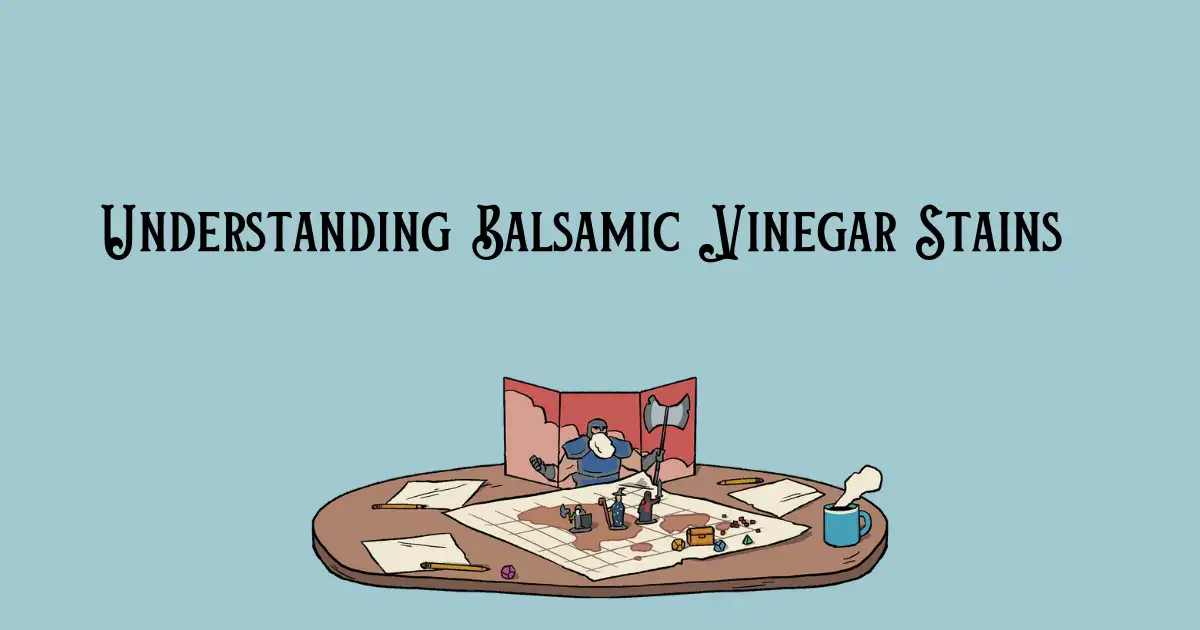Balsamic vinegar is a popular condiment that can add flavour and depth to a variety of dishes. However, it is also known for its staining properties. Balsamic vinegar stains can be difficult to remove from clothes and teeth and frustrating for homeowners and food enthusiasts.
What causes balsamic vinegar stains?
Balsamic vinegar contains natural pigments and acids that can cause stains on clothes and teeth. When balsamic vinegar comes into contact with fabric or tooth enamel, it can leave behind a dark, stubborn stain.
How to identify balsamic vinegar stains on clothes and teeth
Balsamic vinegar stains on clothes are typically dark and may be accompanied by a strong odour. On teeth, balsamic vinegar stains may appear as yellow or brown discolouration.
Why balsamic vinegar stains are difficult to remove
Balsamic vinegar stains are difficult to remove because they contain natural pigments and acids that can penetrate fabric fibres and tooth enamel. Additionally, if left untreated, balsamic vinegar stains can set in and become even more challenging to remove.
What Are The White Spots In Balsamic Vinegar?
Balsamic vinegar aficionados may occasionally notice small white spots floating in their beloved condiment, sparking curiosity and perhaps a touch of concern. Fear not, for these minute specks are a natural occurrence and pose no harm to the quality or flavour of the vinegar.
These white spots appear due to the formation of harmless cellulose crystals, which can transpire over time as the vinegar matures in the bottle. Cellulose is a component found in grapes and is simply a result of the natural fermentation process, which contributes to the unique character of each balsamic vinegar batch.
Much like the invisible growth of fine wine, the development of cellulose crystals in balsamic vinegar indicates its authenticity and traditional crafting methods. These crystals may appear as tiny, white dots suspended in the liquid, enhancing the visual intrigue of the vinegar.
It’s important to note that these particles are not spoilage indicators but a testament to balsamic vinegar’s natural and artisanal production. So, the next time you spot these white specks, rest assured that your balsamic vinegar is undergoing its nuanced evolution, enriching its depth and complexity.
In self-doubt, where one often grapples with uncertainty and introspection, quotes can serve as beacons of inspiration and motivation. These nuggets of wisdom offer solace in moments of hesitation and remind us that self-doubt is a universal experience.
As an expert in personal development, I encourage individuals to embrace self-doubt as a stepping stone rather than a stumbling block. Quotes like “Doubt kills more dreams than failure ever will” or “The only limit to our realization of tomorrow is our doubts of today” resonate deeply, urging us to overcome self-doubt and unlock our full potential. Remember, self-doubt is not a roadblock but a catalyst for growth, and these quotes can be powerful tools in navigating the challenging terrain of self-discovery.
What Is The Residue In Balsamic Vinegar?
Balsamic vinegar is a popular ingredient in salad dressings, marinades, and more. It has a rich, sweet flavour from being aged in wooden barrels. Over time, sediment and deposits can collect at the bottom of the bottle. This dark residue sometimes concerns consumers, but it’s a natural part of quality balsamic vinegar.
The residue consists mainly of tartaric acid, colouring pigments, and sugar. As the vinegar ages, these compounds are concentrated in the sediment. The tartaric acid crystals and dense, sugary syrup cause the bottom layer to become quite thick and sticky.
The sugars also react with the wooden barrel over years of ageing, creating a dark colour. Therefore, a rich, filmy residue indicates a well-aged balsamic vinegar.
Some lower-quality balsamic vinegar is filtered to remove the residue before bottling. However, authentically high-quality traditional balsamic vinegar will feature the sediment. It’s perfectly safe to consume once shaken or stirred into the vinegar.
The residue itself has an intensely sweet flavour. So, there’s no need to be alarmed by its presence in a good-aged balsamic vinegar. It proves your balsamic has been carefully crafted and barrel-aged to create complex, sweet flavours.
How Does Vinegar Remove Stains?
Vinegar is a mild acid that can effectively remove many types of stains. The acetic acid in vinegar breaks down the stain, causing particles to attach to the fabric. Here’s a closer look at how it works:
Vinegar contains acetic acid, which can dissolve residue from stains attached to fabric. Things like grease, coffee, wine, and fruit juice contain particles that bind to fabric fibers. Acetic acid breaks down those particles, separating them from the fibres. This allows the stains to be rinsed clean with water after vinegar treatment. Start by mixing equal parts vinegar and water. Test on a small area first before treating the entire stain.
There are a couple of ways you can apply vinegar to a stain. Dab vinegar directly on the spot for minor stains and let it sit for a few minutes before rinsing. For more prominent stains, soak the fabric in a basin with diluted vinegar water for 15-30 minutes before washing as usual. The vinegar soak allows the acetic acid to break down the stain bonds. For extra stubborn stains, apply vinegar, let it sit for a few minutes, and then toss it in the wash for a regular cycle. The washing machine’s agitation will help lift the loosened stain particles away.
While vinegar is safe for most washable fabrics, always check care labels first. It is not recommended for use on silk or delicate fabrics. Undiluted vinegar may discolour some fabrics or eat away at fibres over time. Be sure to rinse thoroughly after vinegar treatment. Also, white vinegar has a strong scent initially, but it will dissipate as the fabric dries. Vinegar is an effective eco-friendly stain remover for dozens of common household stains. Keep a spray bottle filled with vinegar and one part water in the laundry room.
Removing Balsamic Vinegar Stains from Clothes
Pretreating balsamic vinegar stains
It is crucial to act quickly to remove balsamic vinegar stains from clothes. Start by blotting the stain with a clean, damp cloth to remove excess vinegar. Then, apply a stain remover or laundry detergent directly to the stain and let it sit for at least 15 minutes before washing.
Washing balsamic vinegar-stained clothes
When washing balsamic vinegar-stained clothes, use the hottest water recommended for the fabric and add a laundry booster or vinegar to the wash cycle. Avoid using bleach, which can react with vinegar and worsen the stain.
Alternative methods for removing balsamic vinegar stains from clothes
If traditional stain removal methods do not work, alternative methods exist for removing balsamic vinegar stains from clothes. These include using a mixture of baking soda and water or applying a paste of vinegar and baking soda directly to the stain.
Removing Balsamic Vinegar Stains from Teeth
Brushing and flossing to remove balsamic vinegar stains
To remove balsamic vinegar stains from your teeth, brush and floss regularly. This can help remove surface stains and prevent future staining.
Using whitening products to remove balsamic vinegar stains
Whitening products, such as toothpaste or whitening strips, can also effectively remove balsamic vinegar stains from teeth. However, using these products as directed and avoiding overuse is essential, as they can cause tooth sensitivity.
Professional dental cleaning for balsamic vinegar stains
Professional dental cleaning may be necessary for more stubborn balsamic vinegar stains on teeth. During a dental cleaning, a dentist or dental hygienist will use specialized tools to remove stains and buildup from the teeth.
Preventing Future Balsamic Vinegar Stains
Tips for avoiding balsamic vinegar stains on clothes and teeth
To prevent balsamic vinegar stains on clothes, avoid wearing light-coloured clothing when cooking or serving balsamic vinegar. To prevent balsamic vinegar stains on teeth, rinse your mouth with water after consuming balsamic vinegar. Avoid brushing your teeth immediately after, as this can spread the vinegar around your mouth.
Best practices for handling and serving balsamic vinegar
To avoid spills and stains, take and serve balsamic vinegar carefully. Use a pour spout or dropper to control the amount of vinegar you use, and wipe up any spills immediately.
Alternative uses for balsamic vinegar to avoid staining
If you are concerned about balsamic vinegar stains, there are alternative uses for balsamic vinegar that do not involve direct contact with fabric or teeth. These include using balsamic vinegar as a marinade or salad dressing or drizzling overcooked vegetables or fruit.
Conclusion
Balsamic vinegar is a delicious and versatile condiment that can add flavour to a variety of dishes. However, it is important to understand its staining properties and take steps to prevent and remove stains from clothes and teeth. Following the tips and methods outlined in this guide, you can enjoy balsamic vinegar without fear of staining.
Frequently Asked Questions
What is balsamic vinegar?
Balsamic vinegar is a dark, concentrated vinegar made from the cooked juice of pressed grapes. It originates from Italy and has a sweet and tangy flavour with complex undertones. It is often used in salad dressings, marinades, and sauces to enhance the taste of various dishes.
How do balsamic vinegar stains occur?
Balsamic vinegar stains occur when the dark liquid comes into contact with fabric or surfaces. Accidental spills while cooking, dining, or handling the vinegar bottle can lead to stains. Balsamic vinegar’s dark colour and sticky consistency make it particularly challenging to remove if not addressed promptly.
What surfaces are susceptible to balsamic vinegar stains?
Balsamic vinegar stains can affect various surfaces, including clothing, tablecloths, upholstery, carpets, and kitchen countertops. The acidic nature of the vinegar can cause discolouration and damage if not adequately treated.
How should I deal with a balsamic vinegar stain on clothing?
To remove a balsamic vinegar stain from clothing, blot the stain gently with a clean cloth or paper towel to absorb excess liquid. Avoid rubbing, as it may spread the stain further. Rinse the stained area under cold water to dilute the vinegar. Then, pretreat the stain with a mixture of liquid detergent and water before laundering as usual. Consider using a stain remover or taking the garment to a professional cleaner if the stain persists.
How can I remove balsamic vinegar stains from hard surfaces?
To remove balsamic vinegar stains from hard surfaces like countertops or floors, wipe away any excess vinegar with a paper towel. Mix a solution of equal parts water and white vinegar, and gently scrub the stained area using a sponge or cloth. Rinse the surface thoroughly with water and dry it with a clean cloth. If the stain remains, try using a mild abrasive cleaner, but avoid damaging delicate surfaces.

A Blogger, Author and Researcher! Gohar Aalam is recognized as a full-time blogger for Health and Tech Niches. I’m a Fountainhead of Gethealthup.com, will provides high quality knowledge.








